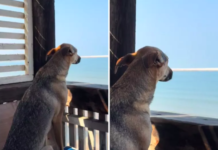Table of Contents
ToggleLast Updated on November 11, 2023 by Fumipets
Revolutionizing Canine Behavior: Lion Toy Unveils Insights into Reactive Dogs
A Pawsitively Tense Encounter: Reactive Dog Faces Off With Lion Toy
In a viral revelation that has the internet buzzing, dog trainer Ian Grant, the brain behind Vermont Dog Boarding and Behavior, has unleashed an unconventional technique to assess and manage reactive dogs. The star of the show? A simple lion toy that’s sending shockwaves through the world of canine behavior.
The Lion’s Roar: A Method as Old as Time
Owners grappling with highly reactive dogs often find themselves in a quagmire of frustration. Seeking solutions, many turn to dog trainers, and Ian Grant’s approach has taken the internet by storm. While the lion toy technique might seem groundbreaking, Grant notes that its roots stretch back decades, borrowing the idea from a friend.
Reactive dogs, characterized by heightened fear and overstimulation, can react excessively to everyday stimuli. Cornell University’s College of Veterinary Medicine sheds light on this phenomenon, emphasizing that not all reactive dogs are inherently aggressive, but their reactivity may lead to aggressive behavior.
Decoding Reactivity: A Blend of Genetics and Experience
Reactivity in dogs can stem from genetic predispositions, but it’s often influenced by a lack of socialization, previous negative experiences, or inadequate training. Grant’s lion toy technique aims to delve into a dog’s reactive tendencies, offering insights into their emotions and behavioral triggers.
Boot’s Journey: A Black Lab Mix Takes Center Stage
Grant shared the groundbreaking technique in a September 7 Instagram post, showcasing Boot, a black Lab mix, facing off with the inanimate lion. The video garnered over 8.1 million views, attesting to its efficacy in capturing the audience’s attention.
By allowing Boot the space to assess the lion on his terms, Grant deciphered the dog’s reactions. The technique offers a unique perspective, providing valuable information without immediate intervention. Boot’s owner, rather than reassuring verbally, moved towards the lion, demonstrating that there was no cause for fear.
Beyond the Lion’s Mane: Applying the Technique in Real-Life Situations
Grant emphasizes that the lion toy technique is not a training tool but rather a method for understanding a dog’s reactions and assessing their comfort levels. However, he suggests that if a dog is afraid of inanimate objects, this technique can be incorporated into their training.
In situations where a dog is reacting intensely, Grant advises creating space and exiting the scenario. Reactivity beyond a certain threshold makes it challenging for dogs to comprehend teachable moments. Seeking professional help and establishing clear rules and boundaries at home are crucial components of addressing reactivity.
Structuring Success: The Role of Routine and Patience
Grant sheds light on the significance of a structured routine at home in alleviating a dog’s reactivity. Dogs, like humans, thrive on clarity and structure, making a consistent routine an invaluable element. Grant emphasizes the need for direction before correction, promoting a positive and clear environment for the dog.
As eager as owners may be for instant changes in their dog’s reactivity, Grant underscores the importance of time, patience, and consistency. Behavioral transformations may take up to 90 days, reinforcing the idea that successful dog training is a journey rather than a sprint.
Conclusion: Transforming Reactivity with Compassion and Understanding
In the intricate world of canine behavior, Ian Grant’s lion toy technique emerges as a beacon of insight, unraveling the layers of reactive tendencies in dogs. As owners navigate the challenges of reactive behavior, this unconventional approach offers a fresh perspective, blending compassion with a deep understanding of a dog’s emotional landscape. In the journey to transform reactivity, time-tested principles of patience, consistency, and professional guidance pave the way for a harmonious coexistence between pets and their devoted owners.
For more information, visit Newsweek.


















